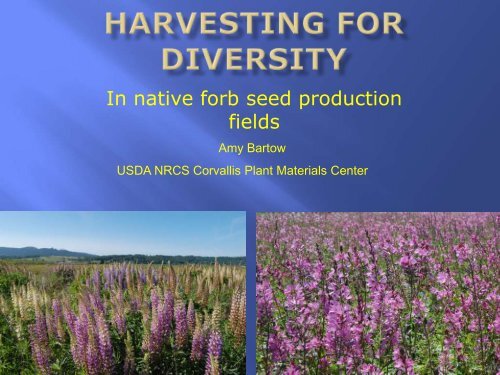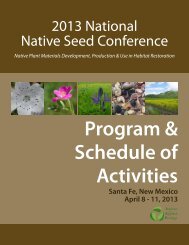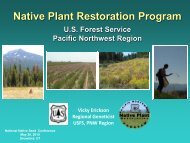Presentation (PDF) - National Native Seed Conference
Presentation (PDF) - National Native Seed Conference
Presentation (PDF) - National Native Seed Conference
You also want an ePaper? Increase the reach of your titles
YUMPU automatically turns print PDFs into web optimized ePapers that Google loves.
In native forb seed production<br />
fields<br />
Amy Bartow<br />
USDA NRCS Corvallis Plant Materials Center
• One of 27 centers across the US.<br />
• Serving western Washington, Oregon,<br />
and northwest California.<br />
• Since 1957, the Corvallis Plant<br />
Materials Center (PMC) has developed<br />
conservation plants and planting<br />
technology to solve resource concerns<br />
critical to the Pacific Northwest.<br />
• A unit of the USDA Natural Resources<br />
Conservation Service (NRCS), the PMC<br />
works in partnership with local, state,<br />
federal and private organizations to<br />
develop new technology in plant<br />
propagation and establishment, seed<br />
production, re-vegetation, restoration<br />
and erosion control.
• Germination<br />
protocols<br />
• <strong>Seed</strong> and plant<br />
production<br />
• Establishment<br />
methods/ guidelines
• <strong>National</strong> Park<br />
Service<br />
• Bureau of Land<br />
Management<br />
• United States Fish<br />
and Wildlife Service<br />
• United States Forest<br />
Service
• Over hundred species researched<br />
• In 2010, 60 different production plots<br />
• 50 species<br />
• Plots range from 100 sq ft to half an acre
• Genetically<br />
uniform<br />
• Rapid,<br />
uniform<br />
growth rate
• Little or no<br />
seed<br />
dormancy:<br />
rapid<br />
germination<br />
• Early vigor,<br />
competes<br />
well with<br />
weeds
• Even flowering and seed set<br />
• Non-shattering seed
• Genetically nonuniform<br />
• Variable growth<br />
rate
• Low seedling vigor, slow to establish
• Medium to high seed dormancy, variable<br />
germination
• Uneven<br />
flowering and<br />
seed set<br />
• Shattering<br />
seed
• Genetic diversity is important!<br />
• We don’t want to lose it with harvest<br />
methods.<br />
• Makes harvesting low yielding or time<br />
consuming. (Prices of native seed reflect<br />
this!)<br />
• Traditional harvest methods are not<br />
always the best choice for native forbs.
• How uniformly does the seed mature on<br />
each plant<br />
• How uniformly does the seed mature<br />
across the entire field (between the<br />
plants)<br />
• How easily does the seed shatter<br />
• Are there significant physical differences<br />
in the plants that might make one plant<br />
more harvestable than another (size,<br />
prostrate vs upright)
• Combining<br />
• Flail-vacs or <strong>Seed</strong><br />
Strippers<br />
• Modified swathers<br />
• Weed Fabric<br />
• Hand
• Usually used on grasses and cereals<br />
• One-time harvest<br />
• Very efficient! Makes it possible to have<br />
large fields.<br />
• But for wildflowers
• Can work for certain forb species<br />
• Fields that are uniform in ripening<br />
• Plants that have non-shattering seed<br />
• Examples: Penstemon sp., Prunella<br />
vulgaris, Downingia sp., Lupinus rivularis,<br />
Eriophyllum lanatum.
• Uniform across the<br />
field<br />
• <strong>Seed</strong> doesn’t<br />
shatter easily<br />
• But shatters once<br />
it is cut
• Maturity nonuniform<br />
across<br />
the field (very<br />
long flowering<br />
period)<br />
• <strong>Seed</strong>s DO NOT<br />
shatter<br />
• Drying on tarps<br />
for extended<br />
time period<br />
helps loosen the<br />
seed
• Maturity is<br />
not<br />
uniform<br />
across the<br />
field<br />
• But seed<br />
does not<br />
shatter
PROS<br />
• Very Efficient, Possible to<br />
have very large fields<br />
• If seed maturity is uniform<br />
within a plant or if seed<br />
does not shatter easily<br />
seed yields can be very<br />
high.<br />
• If seed ripening is<br />
generally uniform across<br />
the field, most plants will<br />
contribute their genetics<br />
to the harvest.<br />
CONS<br />
• Must have a very clean<br />
field, or easy to clean seed<br />
crop<br />
• If seed maturity is variable<br />
within a plant or if seed<br />
shatters easily yields can<br />
be low<br />
• If seed ripening is nonuniform<br />
across the field,<br />
only the plants that have<br />
mature seed at harvest<br />
time will be contributing<br />
their genetics to the<br />
harvest.
• These machines allow for multiple (topdown)<br />
harvests<br />
• Adjustable in height<br />
• Good for small or large fields<br />
• Cuts down on cleaning time (only seed is<br />
stripped form the plant, no threshing<br />
needed).<br />
• Examples: Ranunculus sp.<br />
• Yarrow, Asters
• Maturity fairly even<br />
across the field, can<br />
do multiple harvests<br />
• <strong>Seed</strong>s shatter easily
• Maturity<br />
fairly even<br />
across the<br />
field,<br />
• <strong>Seed</strong>s<br />
shatter<br />
easily.<br />
• Only works<br />
once.
• Very uneven<br />
maturity<br />
• <strong>Seed</strong>s fly away<br />
when mature<br />
• Plants tolerate<br />
multiple harvests
PROS<br />
• Works well for seeds<br />
that shatter easily<br />
• Works well for fields<br />
that do not ripen<br />
evenly (multiple<br />
harvests!)<br />
• Adjust height to<br />
include large and<br />
small plants in the<br />
harvest<br />
• Very easy to collect<br />
seed from every plant<br />
in the field<br />
CONS<br />
• Tractor tires run<br />
over plants and can<br />
damage plants and<br />
flatten seed heads<br />
(they won’t get<br />
harvested). Need to<br />
leave space when<br />
building the fields<br />
for the tires to drive<br />
on
• Swathers that collects cut material<br />
• Can be placed on tarps to catch shattering<br />
seed as the plant material dries<br />
• Mechanized hand harvesting<br />
• Examples:<br />
Eriogonum sp.,<br />
Clarkia sp.,<br />
Sisyrinchium sp.
• Variable<br />
maturity<br />
• Doesn’t<br />
shatter easily<br />
• Green<br />
material stuck<br />
to the insides<br />
of combine<br />
• Dried material<br />
shatters easily
• Even<br />
maturity<br />
• Very short<br />
• <strong>Seed</strong>s do not<br />
shatter easily<br />
• Capules open<br />
slowly when<br />
dry
PROS<br />
• Good for fields that are<br />
uniformly mature<br />
• A must for seeds that<br />
shatter as they are being<br />
harvested or when they are<br />
drying<br />
• If seed maturity is uniform<br />
within a plant or if seed<br />
does not shatter easily seed<br />
yields can be very high.<br />
• If seed ripening is generally<br />
uniform across the field,<br />
most plants will contribute<br />
their genetics to the<br />
harvest.<br />
CONS<br />
• Requires a fabricator!<br />
• Have to be able to handle<br />
the material after it is cut.<br />
Can be time consuming.<br />
• Must have a very clean<br />
field, or easy to clean seed<br />
crop<br />
• If seed maturity is variable<br />
within a plant or if seed<br />
shatters easily yields can be<br />
low<br />
• If seed ripening is nonuniform<br />
across the field,<br />
only the plants that have<br />
mature seed at harvest<br />
time will be contributing<br />
their genetics to the<br />
harvest.
• Weed fabric can be used to keep out<br />
weeds and as a passive seed collector<br />
• Good for species that shatter easily,<br />
mature unevenly on the plants and<br />
across the field.<br />
• Good choice for small annual plants<br />
• Almost possible to get every seed from<br />
each plant!
• Varible ripening<br />
• Very short<br />
• <strong>Seed</strong>s ripen and<br />
immediately<br />
shatter
• Highly<br />
variable<br />
ripening<br />
(months)<br />
• Very short<br />
• <strong>Seed</strong>s<br />
immediatley<br />
shoot out of<br />
the capsule<br />
when<br />
mature.
• Variable<br />
ripening<br />
• Tiny seeds<br />
shatter<br />
upon<br />
maturity<br />
• <strong>Seed</strong>s<br />
shatter<br />
while<br />
harvesting
PROS<br />
• Good for small scale<br />
production (specialty<br />
species)<br />
• Highest yields per plant<br />
• Efficient, sweep up<br />
seeds after they shatter<br />
• Best choice for<br />
protecting diversity<br />
• No weeds!!!<br />
• No threshing!!<br />
CONS<br />
• Limited to small scale<br />
production (0.25 acre)<br />
• Labor intensive, grow<br />
plants in containers, lay<br />
out weed fabric,<br />
transplant plants into<br />
holes cut in the fabric.<br />
• Rhizomatous species<br />
will not do as well in the<br />
weed fabric, they will<br />
come up underneath it.<br />
• Can harbor mice under<br />
the weed fabric.
Combined populations from all over the<br />
Willamette Valley<br />
Combined individual populations into<br />
“blocks”<br />
Blocks were planted together to allow<br />
interbreeding<br />
Blocks could be harvested separately<br />
Divided seed among various growers
• Threatened species<br />
• Mostly small,<br />
isolated<br />
populations exist<br />
• Very easy to grow<br />
• High agronomic<br />
potential
• A lot of planning in the<br />
early stages of wild seed<br />
collection and growout<br />
• Create a balanced<br />
contribution from each<br />
population<br />
• Keep track of populations<br />
by rows.<br />
• Rows were replicated<br />
across the field<br />
• Allows for tracking and<br />
accommodation per<br />
population.
• 2009 first growing<br />
season<br />
• Grew 4000 plugs<br />
from wild collected<br />
seed<br />
• Created seed<br />
increase plots for<br />
two recovery zones<br />
• Produced over 80<br />
lbs of seed.
• 3000 acre complex<br />
of wetlands (and<br />
some uplands)<br />
• Unique partnership<br />
of many agencies<br />
and non-profits<br />
• Working together<br />
to protect and<br />
restore the<br />
wetlands
• 30 different species<br />
• Annuals<br />
• Hard to harvest<br />
• Highly managed<br />
small plots
• Grow plugs in a<br />
greenhouse from<br />
wild collected seed<br />
• Transplant them<br />
into weed fabric in<br />
early spring<br />
• Harvest multiple<br />
times during the<br />
growing season
If you must do a one-time harvest, but will<br />
be harvesting the same field for a couple<br />
of years for the same project,<br />
consider an early harvest one year, a mid<br />
harvest another year, and a late harvest<br />
another year.<br />
This will insure that all plants (regardless of<br />
phenology) contribute their genetics to<br />
the harvest.
Remember to Consider:<br />
• How uniformly does the seed mature on<br />
each plant and the entire field<br />
• How uniformly does the seed mature<br />
across the entire field (between the<br />
plants)<br />
• How easily does the seed shatter<br />
• Are there significant physical differences<br />
in the plants




